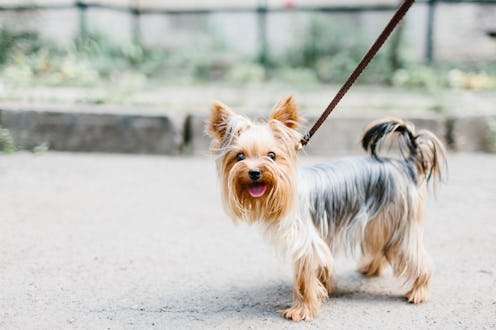Life
If Your Dog Pulls On Their Leash During Walks, Experts Say This Can Stop It

The moment you get your dog's leash out, they probably go wild with excitement at the prospect of getting to go for a stroll with you outdoors. But if you're trying to get your dog to stop pulling on their leash, a simple walk can seem more stressful than fun. Your best bet is to encourage good behavior, so that they grow to realize that walking right by your side is what you want them to do, according to experts.
Start off by using treats to positively reinforce good behavior instead of negative tactics like yelling at your dog for pulling. "Start inside your home, in a non-distracting environment where the dog can pay attention easily," Russell Hartstein, CDBC, CPDT-KA, a certified professional dog trainer and founder of Fun Paw Care, tells Bustle. "Offer your dog the treats at your hip where you want them to be," he says. Let the leash be loose and when your dog looks back at you, mark that good behavior with a treat.
Once your pup learns to stay by your side (where they've learned the treats are) instead of straining way ahead of you, you can take the practice into another room of your home, to your yard, and then eventually to the street. Even though there are plenty of squirrels or pinecones to catch your dog's eye, make sure that they're aware of you. "You want to 'be the cookie' and focus of attention when outside," Hartstein says. "The key is to go slow and steady and use graduated incremental increases in exposure and difficulty along the way."
Keep in mind that this is a process, not something that either of you are going to master in the first day or so, Danielle Müehlenberg, a certified dog trainer and blogger, tells Bustle. "Do not get frustrated and don’t stop your leash training," she says. Don’t reward your dog for unwanted behavior by letting them pull you down the street. If you stop correcting your pup when they pull, they can fall back into the habit of straining instead of walking calmly by your side, so pay attention. Whatever you do, never smack at the leash and don't get a prong or choke collar, Müehlenberg says. Instead, be consistent and patient with your training. You will see the best results with consistency and patience, rather than frustration.
You might assume that a regular leash and collar is your best bet for walking your dog, but that isn't necessarily the case. "I recommend using a harness for all dogs, even large breeds," Stephanie Mantilla, a positive reinforcement-based animal trainer at Curiosity Trained, tells Bustle. "The best styles are a figure-eight style because the adjustable straps don't cross over their shoulders which prevents rub spots," she says.
"While not a positive reinforcement method of training, a gentle leader is another tool people can use while they're training their dog not to pull," Mantilla says. In case you aren't familiar with this tool, it's a strap that loops over your dog's nose and then attaches to their collar so that when your dog pulls, the strap gentle guides their nose down, discouraging them from continuing to pull.
If you're still having trouble with teaching your dog not to pull on their leash, you can always check in with their veterinarian, who might have some suggestions or be able to refer you to a certified animal trainer for some extra help. Whatever you do, make sure to be patient with your sweet pup, who's probably just so excited to be exploring the outside world.
This article was originally published on